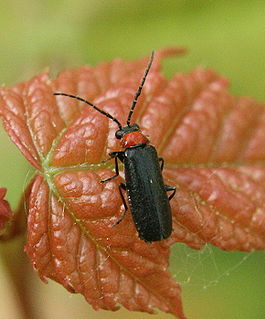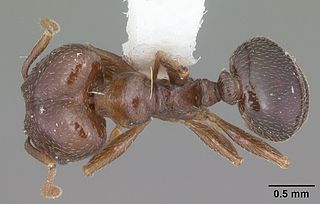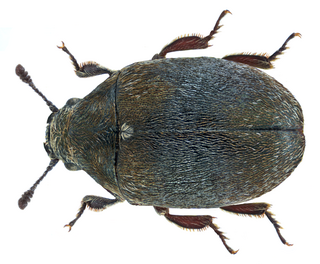
Entomobryidae, sometimes called "slender springtails", is a family of springtails characterised by having an enlarged fourth abdominal segment and a well-developed furcula. Species in this family may be heavily scaled and can be very colourful. The scale-less Entomobryidae are commonly caught in pitfall traps around the planet, and also occur in canopy faunas high up in trees. There are more than 700 described species in Entomobryidae.
Gnadochaeta is a genus of bristle flies in the family Tachinidae. There are at least 30 described species in Gnadochaeta.

Kateretidae is a family of short-winged flower beetles in the suborder Polyphaga. There are about 11 genera and at least 40 described species in Kateretidae.

Cerylonidae are small to tiny, smooth, shiny, hairless beetles, only lightly punctured. There are about 450 species worldwide in 50 or so genera, mostly tropical and subtropical. They are most common under the bark of dead trees, but can also occur in compost and other decaying plant material. Little is known specifically about their biology but they are thought to be either predators that feed on other small animals or fungus eating.

Technomyrmex difficilis, known generally as the white-footed ant or difficult techno ant, is a species of odorous ant in the family Formicidae.
Pachybrachis nigricornis is a species of case-bearing leaf beetle in the family Chrysomelidae. It is found in Central America and North America.
Silis crucialis is a species of soldier beetle in the family Cantharidae. It is found in North America.

Silis is a genus of soldier beetles in the family Cantharidae. There are at least 80 described species in Silis.
Silis lutea is a species of soldier beetle in the family Cantharidae. It is found in North America.
Lecontia is a genus of conifer bark beetles in the family Boridae. There are at least two described species in Lecontia.

Pheidole hyatti is an ant, a species of higher myrmicine in the family Formicidae.
Litolinga is a genus of stiletto flies in the family Therevidae. There are at least two described species in Litolinga.
Onthophagus landolti is a species of dung beetle in the family Scarabaeidae.

Pheidole crassicornis is an ant, a species of higher myrmicine in the family Formicidae.
Melanoplus cinereus, the grayish sagebrush grasshopper, is a species of spur-throated grasshopper in the family Acrididae. It is found in North America.

Morychus is a genus of pill beetles in the family Byrrhidae. There are at least three described species in Morychus.
Silis carmelita is a species of soldier beetle in the family Cantharidae. It is found in North America.
Miastor is a genus of gall midges and wood midges in the family Cecidomyiidae. There are about six described species in Miastor.
Hybomitra difficilis is a species of horse flies in the family Tabanidae.

Trichopsocus is a genus of lash-faced psocids in the family Trichopsocidae. There are about nine described species in Trichopsocus.











